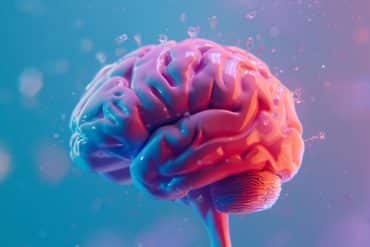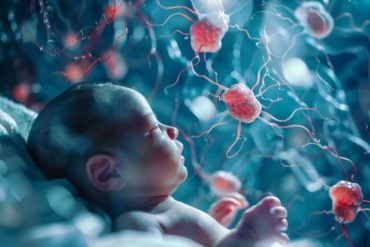Summary: Herpes virus simplex type 1 infection can spread to the fetal brain during pregnancy, resulting in an increased risk of neurodevelopmental disabilities and neurological deficits.
Source: PLOS
Three cell-based models shed light on how herpes simplex virus type 1 (HSV-1) infection, which can spread to the fetal brain during pregnancy, may contribute to various neurodevelopmental disabilities and long-term neurological problems into adulthood, according to a study published October 22, 2020 in the open-access journal PLOS Pathogensby Pu Chen and Ying Wu of Wuhan University, and colleagues.
HSV-1 is a highly prevalent pathogen that can cause lifelong neurological problems such as cognitive dysfunction, learning disabilities, and dementia. But progress in understanding the role of HSV-1 in human fetal brain development has been hampered by restricted access to fetal human brain tissue as well as limitations of existing animal models.
To address this gap in knowledge, the researchers generated three different cell-based neurodevelopmental disorder models, including a 2D layer of cells and a 3D brain-like structure. These models are based on human induced pluripotent stem cells (hiPSCs) – immature, embryonic stem cell-like cells that are generated by genetically reprogramming specialized adult cells.
HSV-1 infection in neural stem cells derived from hiPSCs resulted in activation of the caspase-3 apoptotic pathway, which initiates programmed cell death. HSV-1 infection also impaired the production of new neurons, and hindered the ability of hiPSC-derived neural stem cells to convert into mature neurons through a process called neuronal differentiation.

Moreover, the HSV-1-infected brain organoids mimicked the pathological features of neurodevelopmental disorders in the human fetal brain, including impaired neuronal differentiation and abnormalities in brain structure. In addition, the 3D model showed that HSV-1 infection promotes the abnormal proliferation and activation of non-neuronal cells called microglia, accompanied by the activation of inflammatory molecules, such as TNF-α, IL-6, IL-10, and IL-4.
According to the authors, the findings open new therapeutic avenues for targeting viral reservoirs relevant to neurodevelopmental disorders.
The authors add, “This study provides novel evidence that HSV-1 infection impaired human brain development and contributed to the neurodevelopmental disorder pathogen hypothesis”.
About this neurodevelopment research news
Source: PLOS
Contact: Pu Chen – PLOS
Image: The image is in the public domain
Original Research: Open access.
“Herpes simplex virus type 1 infection leads to neurodevelopmental disorder-associated neuropathological changes” by Pu Chen et al. PLOS Pathogens
Abstract
Herpes simplex virus type 1 infection leads to neurodevelopmental disorder-associated neuropathological changes
Neonatal herpes simplex virus type 1 (HSV-1) infections contribute to various neurodevelopmental disabilities and the subsequent long-term neurological sequelae into the adulthood. However, further understanding of fetal brain development and the potential neuropathological effects of the HSV-1 infection are hampered by the limitations of existing neurodevelopmental models due to the dramatic differences between humans and other mammalians. Here we generated in vitro neurodevelopmental disorder models including human induced pluripotent stem cell (hiPSC)-based monolayer neuronal differentiation, three-dimensional (3D) neuroepithelial bud, and 3D cerebral organoid to study fetal brain development and the potential neuropathological effects induced by the HSV-1 infections. Our results revealed that the HSV-1-infected neural stem cells (NSCs) exhibited impaired neural differentiation. HSV-1 infection led to dysregulated neurogenesis in the fetal neurodevelopment. The HSV-1-infected brain organoids modelled the pathological features of the neurodevelopmental disorders in the human fetal brain, including the impaired neuronal differentiation, and the dysregulated cortical layer and brain regionalization. Furthermore, the 3D cerebral organoid model showed that HSV-1 infection promoted the abnormal microglial activation, accompanied by the induction of inflammatory factors, such as TNF-α, IL-6, IL-10, and IL-4. Overall, our in vitro neurodevelopmental disorder models reconstituted the neuropathological features associated with HSV-1 infection in human fetal brain development, providing the causal relationships that link HSV biology with the neurodevelopmental disorder pathogen hypothesis.






